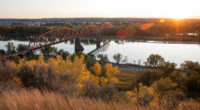America’s 11 Most Endangered Historic Places in 2021

Selma to Montgomery March Camp Sites, in Selma, Alabama. Photo © Phillip Howard

Trujillo Adobe in Riverside, California. Photo © Spanish Town Heritage Foundation

Summit Tunnels 6 & 7 and Summit Camp Site in Truckee, California. Photo © Phil Sexton

Georgia B. Williams Nursing Home in Camilla, Georgia. Photo © Rebbecca Fenwick

Morningstar Tabernacle No.88 Order of Moses Cemetery and Hall in Cabin John, Maryland. Photo © Friends of Moses Hall

Boston Harbor Islands in Boston, Massachusetts. Photo © Boston Harbor Now

Sarah E. Ray House in Detroit, Michigan. Photo © Aaron Schillinger

The Riverside Hotel in Clarksdale, Mississippi. Photo © Jai Williams

Oljato Trading Post in San Juan County, Utah. Photo © Steven Cornell

Pine Grove Elementary School in Cumberland, Virginia. Photo © Preservation Virgina










The National Trust for Historic Preservation has released its annual list of America’s 11 Most Endangered Historic Places, with several buildings significant to Black history and the civil rights movement.
Created every year since 1988, the list is released by the National Trust to garner support in protecting and sharing places’ unique histories, many of which are decrepit or at risk of being destroyed. “This list draws attention to historic places we must protect and honor—not only because they define our past, but also because the stories they tell offer important lessons for the way forward together,” said Paul Edmondson, president of the National Trust for Historic Preservation, in a statement. “These 11 places celebrate the fact that our past is a multicultural fabric that, when pieced together, reveals our true identity as Americans.”
This year’s list includes Threatt Filling Station and Family Farm, a Black-owned and -operated gas station along Route 66 in Oklahoma from the Jim Crow era, which was used as a safe haven for Black travelers, and its farm reportedly provided refuge to Black Oklahomans displaced by the Tulsa Race Massacre a century ago.
Also spotlighted is a Virginia school created by Julius Rosenwald to serve African Americans in the early 1900s, Pine Grove Elementary School. However, proposed construction of a landfill nearby threatens the school, which currently operates as a community center. In Maryland, Morningstar Tabernacle No.88 Order of Moses Cemetery and Hall join the list, which were established around 1885 near post-Emancipation Black settlement Gibson Grove.
Other places in America’s Deep South are the Riverside Hotel in Clarksdale, Mississippi, which was one of the state’s only Black hotels and boarding homes in the Jim Crow era, and the former Georgia residence of Black midwife Beatrice Borders, who managed the building as a health facility for thousands of black women during the Jim Crow era. Also on the list this year are Alabama farms owned by African Americans who offered their properties as overnight campsites to civil rights marchers, including Dr. Martin Luther King Jr., Coretta Scott King, and Congressman John Lewis. They are located along the Selma to Montgomery National Historic Trail.
California sites honored on the list are the Trujillo Adobe, built in 1862 by Lorenzo Trujillo, a Native American who led expeditions across the Old Spanish Trail, enabling immigrants to settle inland California, as well as Summit Camp Site and tunnels, where thousands of Chinese railroad workers constructed the Transcontinental Railroad in the 1860s through the Sierra Nevada mountains.
Rounding out the National Trust’s 2021 endangered list are several places in the north: the Detroit home of civil rights activist Sarah E. Ray, and the Boston Harbor Islands—home to significant Native American archaeological finds and Fort Standish, used during World War II.
The annual list spotlights important places in the U.S.’s heritage from an architectural perspective that could be damaged or lost indefinitely, without advocacy and action. Less than five percent of the more than 300 places highlighted by the National Trust have been lost. Placement on the list is “often the saving grace for important cultural landmarks,” according to a statement, and the first step in protecting such places.
Last year’s list comprised places like SOM’s first hotel The Terrace Plaza Hotel in Cincinnati, Puerto Rico’s Ponce Historic Zone, and the historical Rassawek capital of the Monacan Indian Nation in Columbia, Virginia.














